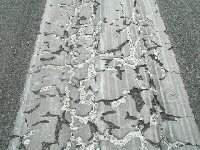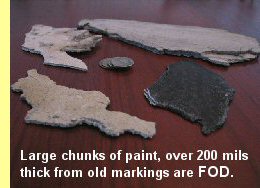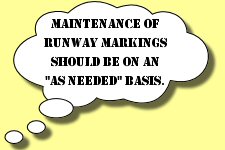|
Back to Webletter
Highways vs Airfields
By Donna Speidel
-Heard on Southwest Airlines just after a very hard landing in Salt Lake City:
The flight attendant came on the intercom and said, "That was quite a bump and I know what ya'll
are thinking. I'm here to tell you it wasn't the airline's fault, it wasn't the pilot's fault, it
wasn't the flight attendants' fault.....it was the asphalt!"
 Pretty funny! But so often it's true. And sometimes, where those tires touch down
is particularly rough because the runway centerline markings are like speed bumps. Many busy
airports lose their centerline markings within days of having it freshly painted because of rubber
from the aircraft tires. So the airfield maintenance crews diligently apply more paint to freshen
it up. And the more paint that's applied, the worse the build up becomes, and if it's asphalt, it
may start to look like this!
Pretty funny! But so often it's true. And sometimes, where those tires touch down
is particularly rough because the runway centerline markings are like speed bumps. Many busy
airports lose their centerline markings within days of having it freshly painted because of rubber
from the aircraft tires. So the airfield maintenance crews diligently apply more paint to freshen
it up. And the more paint that's applied, the worse the build up becomes, and if it's asphalt, it
may start to look like this!
There are differences between highway and airfield markings; and yet airfield
markings are treated in much the same way in terms of maintenance. Customarily, state DOTs send
paint crews out once a year (or more) to repaint road lines, depending upon average daily traffic
 (ADT). Painted markings on airfields don't experience the same kind of traffic wear, and yet
airports all over the world maintain their markings by repainting every one to three years; except
in the case of the runway centerline which often gets painted a lot more frequently than that.
Unfortunately, little, if any, surface preparation is performed prior to applying more paint,
just like highway markings. (I had to say it!) On most of the markings, this frequent
repainting is often not necessary and can lead to other problems that are seldom recognized by
airfield maintenance crews and operations staff.
(ADT). Painted markings on airfields don't experience the same kind of traffic wear, and yet
airports all over the world maintain their markings by repainting every one to three years; except
in the case of the runway centerline which often gets painted a lot more frequently than that.
Unfortunately, little, if any, surface preparation is performed prior to applying more paint,
just like highway markings. (I had to say it!) On most of the markings, this frequent
repainting is often not necessary and can lead to other problems that are seldom recognized by
airfield maintenance crews and operations staff.
Standard centerline marking width on a highway is 4 inches vs. 18-36 inches on a
runway. A 4-inch line on a highway does not have the same surface tension of a 36-inch wide line
on a runway. The wider the painted marking, the higher the surface tension. Paint on a runway
sometimes bonds better to the asphalt than the asphalt does to itself, causing premature cracking
of the asphalt surface. This gives water easy access to the paint and the pavement, undermining both.
A median or two solid yellow center lines dividing opposing lanes of traffic often
split a four-lane highway compared to a typical runway. Each highway lane ranges from 10-12 feet
wide. The markings are 4 to 6 inches wide. But an airfield has a wide expanse of pavement where
markings are not nearly as close together. On a typical commercial runway, the centerline consists
of a 3-foot wide by 120-foot long bar, separated by 80-feet of space. Most commercial runways are
150-foot wide, so the nearest marking to the centerline might be an edgeline 75-feet away. The size
and distance of the lines are understandably larger due to the size and speed of the vehicles using
them; and they are quite visible from long distances, as long as the markings are well maintained.
Traffic flow blows water from highways; runways are crowned and often grooved,
allowing water to flow off the pavement to prevent hydroplaning. However, runways sometimes have high
grass adjacent to the pavement, causing water to pond at the edges. Water accelerates paint wear and
contributes to pavement deterioration.
 With a high volume of traffic, highway lines take a beating and must be remarked at
least annually. On runways, a high volume of traffic buries the runway centerline and other markings
under black, carbonized rubber deposits. But aside from the centerline, runway markings should have a
much longer wear cycle. When the airfield markings are repainted, they should first be surface
blasted, not just painted over. Over-painting on airfields causes the paint to build up, crack and
peel, because the markings are not being worn down with traffic. Snowplows and sweepers can
sometimes dislodge some of the loose paint, but pieces can be found on pavement surfaces. These chunks
containing layers of paint and glass beads constitute FOD (foreign object debris) and, like nuts and
bolts, can be ingested in jet engines, possibly causing premature wear of engine components.
With a high volume of traffic, highway lines take a beating and must be remarked at
least annually. On runways, a high volume of traffic buries the runway centerline and other markings
under black, carbonized rubber deposits. But aside from the centerline, runway markings should have a
much longer wear cycle. When the airfield markings are repainted, they should first be surface
blasted, not just painted over. Over-painting on airfields causes the paint to build up, crack and
peel, because the markings are not being worn down with traffic. Snowplows and sweepers can
sometimes dislodge some of the loose paint, but pieces can be found on pavement surfaces. These chunks
containing layers of paint and glass beads constitute FOD (foreign object debris) and, like nuts and
bolts, can be ingested in jet engines, possibly causing premature wear of engine components.
 Blue-green algae grow in warm, damp environments. On highways, traffic generally
keeps the algae at bay. But on airport surfaces with traffic on a small portion of the paved surface,
algae can spread across the pavement, often obscuring the markings to the point that they appear worn
or gone. Often water blasting alone will clean the algae from the marking, negating the need for
repainting. The picture to the right demonstrates just how much algae can 'take over' an untrafficked
area of an airfield.
Blue-green algae grow in warm, damp environments. On highways, traffic generally
keeps the algae at bay. But on airport surfaces with traffic on a small portion of the paved surface,
algae can spread across the pavement, often obscuring the markings to the point that they appear worn
or gone. Often water blasting alone will clean the algae from the marking, negating the need for
repainting. The picture to the right demonstrates just how much algae can 'take over' an untrafficked
area of an airfield.
 Another problem detected in some parts of the world, predominantly on runways, is rust
staining due to high iron sulfide content in the ground and/or aggregate. When due to rain water
contamination, possibly picked up from the runway surface, the leading edge of the marking and low areas
where the water flows receive the worst stain. When due to ground contamination, the entire marking
becomes rust colored. The color standard for white is no longer within tolerance.
Another problem detected in some parts of the world, predominantly on runways, is rust
staining due to high iron sulfide content in the ground and/or aggregate. When due to rain water
contamination, possibly picked up from the runway surface, the leading edge of the marking and low areas
where the water flows receive the worst stain. When due to ground contamination, the entire marking
becomes rust colored. The color standard for white is no longer within tolerance.
Markings on runways should be viewed and maintained differently than on highways.
Much greater emphasis is placed on highway markings for the safety of the traveling public. However,
even though there are only one or two people maneuvering an aircraft on a runway, the passengers may
number into the hundreds; and they are relying on the ability of the pilots to get them safely to their
 destination. It would seem prudent for airfield operators to focus more attention on the integrity of
their markings, look at them in terms of visibility (both day and night), as well as how they are
affecting the underlying pavement. The pavement, after all, is one of an airport?s biggest assets; but
asphalt pavements on airfields continue to show signs of cracking and spalling, partially due to
repeated repainting of the markings. Maintenance of runway markings should be on an "as needed" basis.
We at Sightline can help your staff determine when it?s needed.
destination. It would seem prudent for airfield operators to focus more attention on the integrity of
their markings, look at them in terms of visibility (both day and night), as well as how they are
affecting the underlying pavement. The pavement, after all, is one of an airport?s biggest assets; but
asphalt pavements on airfields continue to show signs of cracking and spalling, partially due to
repeated repainting of the markings. Maintenance of runway markings should be on an "as needed" basis.
We at Sightline can help your staff determine when it?s needed.
Back to Webletter
|



 Pretty funny! But so often it's true. And sometimes, where those tires touch down
is particularly rough because the runway centerline markings are like speed bumps. Many busy
airports lose their centerline markings within days of having it freshly painted because of rubber
from the aircraft tires. So the airfield maintenance crews diligently apply more paint to freshen
it up. And the more paint that's applied, the worse the build up becomes, and if it's asphalt, it
may start to look like this!
Pretty funny! But so often it's true. And sometimes, where those tires touch down
is particularly rough because the runway centerline markings are like speed bumps. Many busy
airports lose their centerline markings within days of having it freshly painted because of rubber
from the aircraft tires. So the airfield maintenance crews diligently apply more paint to freshen
it up. And the more paint that's applied, the worse the build up becomes, and if it's asphalt, it
may start to look like this!
 (ADT). Painted markings on airfields don't experience the same kind of traffic wear, and yet
airports all over the world maintain their markings by repainting every one to three years; except
in the case of the runway centerline which often gets painted a lot more frequently than that.
Unfortunately, little, if any, surface preparation is performed prior to applying more paint,
just like highway markings. (I had to say it!) On most of the markings, this frequent
repainting is often not necessary and can lead to other problems that are seldom recognized by
airfield maintenance crews and operations staff.
(ADT). Painted markings on airfields don't experience the same kind of traffic wear, and yet
airports all over the world maintain their markings by repainting every one to three years; except
in the case of the runway centerline which often gets painted a lot more frequently than that.
Unfortunately, little, if any, surface preparation is performed prior to applying more paint,
just like highway markings. (I had to say it!) On most of the markings, this frequent
repainting is often not necessary and can lead to other problems that are seldom recognized by
airfield maintenance crews and operations staff.
 With a high volume of traffic, highway lines take a beating and must be remarked at
least annually. On runways, a high volume of traffic buries the runway centerline and other markings
under black, carbonized rubber deposits. But aside from the centerline, runway markings should have a
much longer wear cycle. When the airfield markings are repainted, they should first be surface
blasted, not just painted over. Over-painting on airfields causes the paint to build up, crack and
peel, because the markings are not being worn down with traffic. Snowplows and sweepers can
sometimes dislodge some of the loose paint, but pieces can be found on pavement surfaces. These chunks
containing layers of paint and glass beads constitute FOD (foreign object debris) and, like nuts and
bolts, can be ingested in jet engines, possibly causing premature wear of engine components.
With a high volume of traffic, highway lines take a beating and must be remarked at
least annually. On runways, a high volume of traffic buries the runway centerline and other markings
under black, carbonized rubber deposits. But aside from the centerline, runway markings should have a
much longer wear cycle. When the airfield markings are repainted, they should first be surface
blasted, not just painted over. Over-painting on airfields causes the paint to build up, crack and
peel, because the markings are not being worn down with traffic. Snowplows and sweepers can
sometimes dislodge some of the loose paint, but pieces can be found on pavement surfaces. These chunks
containing layers of paint and glass beads constitute FOD (foreign object debris) and, like nuts and
bolts, can be ingested in jet engines, possibly causing premature wear of engine components.
 Blue-green algae grow in warm, damp environments. On highways, traffic generally
keeps the algae at bay. But on airport surfaces with traffic on a small portion of the paved surface,
algae can spread across the pavement, often obscuring the markings to the point that they appear worn
or gone. Often water blasting alone will clean the algae from the marking, negating the need for
repainting. The picture to the right demonstrates just how much algae can 'take over' an untrafficked
area of an airfield.
Blue-green algae grow in warm, damp environments. On highways, traffic generally
keeps the algae at bay. But on airport surfaces with traffic on a small portion of the paved surface,
algae can spread across the pavement, often obscuring the markings to the point that they appear worn
or gone. Often water blasting alone will clean the algae from the marking, negating the need for
repainting. The picture to the right demonstrates just how much algae can 'take over' an untrafficked
area of an airfield.
 Another problem detected in some parts of the world, predominantly on runways, is rust
staining due to high iron sulfide content in the ground and/or aggregate. When due to rain water
contamination, possibly picked up from the runway surface, the leading edge of the marking and low areas
where the water flows receive the worst stain. When due to ground contamination, the entire marking
becomes rust colored. The color standard for white is no longer within tolerance.
Another problem detected in some parts of the world, predominantly on runways, is rust
staining due to high iron sulfide content in the ground and/or aggregate. When due to rain water
contamination, possibly picked up from the runway surface, the leading edge of the marking and low areas
where the water flows receive the worst stain. When due to ground contamination, the entire marking
becomes rust colored. The color standard for white is no longer within tolerance.
 destination. It would seem prudent for airfield operators to focus more attention on the integrity of
their markings, look at them in terms of visibility (both day and night), as well as how they are
affecting the underlying pavement. The pavement, after all, is one of an airport?s biggest assets; but
asphalt pavements on airfields continue to show signs of cracking and spalling, partially due to
repeated repainting of the markings. Maintenance of runway markings should be on an "as needed" basis.
We at Sightline can help your staff determine when it?s needed.
destination. It would seem prudent for airfield operators to focus more attention on the integrity of
their markings, look at them in terms of visibility (both day and night), as well as how they are
affecting the underlying pavement. The pavement, after all, is one of an airport?s biggest assets; but
asphalt pavements on airfields continue to show signs of cracking and spalling, partially due to
repeated repainting of the markings. Maintenance of runway markings should be on an "as needed" basis.
We at Sightline can help your staff determine when it?s needed.